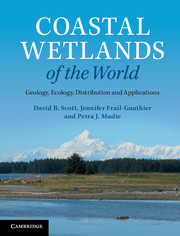Book contents
- Frontmatter
- Contents
- Preface
- List of acronyms and abbreviations
- 1 Introduction: what is covered in this coastal wetlands book?
- 2 Physical aspects: geological, oceanic and climatic conditions
- 3 Zonations and plants: development, stressors and adaptations
- 4 Animals in coastal wetlands: zonation, adaptations and energy flow
- 5 Human intervention causing coastal problems
- 6 Coastal wetlands worldwide: climatic zonation, ecosystems and biogeography
- 7 Examples of North American salt marshes and coastal wetlands
- 8 Examples of South American coastal wetlands
- 9 Africa: selected marsh and mangrove areas
- 10 Europe and Asia: a view of what remains
- 11 Australasia: wetlands of Australia and New Zealand
- 12 Applications in geological monitoring: paleoseismology and paleoclimatology
- 13 Applications in conservation of plant biodiversity and agriculture
- 14 Using mesocosms as a way to study coastal wetlands
- 15 Conclusions and future directions
- References
- Index
- Plate section
5 - Human intervention causing coastal problems
Published online by Cambridge University Press: 05 July 2014
- Frontmatter
- Contents
- Preface
- List of acronyms and abbreviations
- 1 Introduction: what is covered in this coastal wetlands book?
- 2 Physical aspects: geological, oceanic and climatic conditions
- 3 Zonations and plants: development, stressors and adaptations
- 4 Animals in coastal wetlands: zonation, adaptations and energy flow
- 5 Human intervention causing coastal problems
- 6 Coastal wetlands worldwide: climatic zonation, ecosystems and biogeography
- 7 Examples of North American salt marshes and coastal wetlands
- 8 Examples of South American coastal wetlands
- 9 Africa: selected marsh and mangrove areas
- 10 Europe and Asia: a view of what remains
- 11 Australasia: wetlands of Australia and New Zealand
- 12 Applications in geological monitoring: paleoseismology and paleoclimatology
- 13 Applications in conservation of plant biodiversity and agriculture
- 14 Using mesocosms as a way to study coastal wetlands
- 15 Conclusions and future directions
- References
- Index
- Plate section
Summary
Key points
The location of coastal wetlands on deltas, estuaries and lagoons make them targets for landscape alteration by dredging, shipping and air industries; land ‘reclamation’ for agriculture, aquaculture, urban development and tourism has transformed ~30% of the world’s wetlands; population growth, rising sea level, dams and soil desiccation increase wetlands flooding from higher water levels and increased storminess; shrinking Arctic sea ice, permafrost and glacier melting increase erosion, adding to greenhouse gases and change ocean–atmosphere circulations pole-to-pole; replacing salt marsh and mangroves by landfill removes natural shoreline protection, but artificial barriers create worse erosion; attempted wetland recolonization often fails because introduced species are invasive; drainage to control mosquitos and tropical diseases changes wetland productivity; pollution from nitrogen loading and oil spills cause long-lasting damage, up to >30 years.
Human population growth and landscape alteration
Anthropogenic impacts on coastal wetlands include landscape alteration and reclamation of tidal wetlands, accelerated climate warming and sea level rise, spread of alien plant and animal species, construction of dams, draining of tidal wetlands and discharge of pollutants – deliberately or accidentally. Coastal wetlands are particularly vulnerable to the impacts of sea level rise (Cahoon et al., 2006). In the Stern Review of the Economics of Climate Change (Stern, 2007), the costs of future coastal flooding are projected as around US$7.5 to $11 billion per decade for Europe and North America, respectively. Syvitski et al. (2009) have shown that 17 of the world’s largest deltas (Table 5.1) are critically vulnerable to being flooding and converted to open ocean. In the past decade, 85% of these deltas experienced severe flooding, with a total area of 260 000 km2 being temporarily submerged. The Syvitski team estimate that the area vulnerable to flooding could increase by 50% under projected values for twentieth-century sea level rise. In contrast, other models predict that increased storminess will transport more sediment into coastal wetlands and enable salt marshes to keep pace with sea level rise (Schuerch et al., 2013).
- Type
- Chapter
- Information
- Coastal Wetlands of the WorldGeology, Ecology, Distribution and Applications, pp. 44 - 56Publisher: Cambridge University PressPrint publication year: 2014



